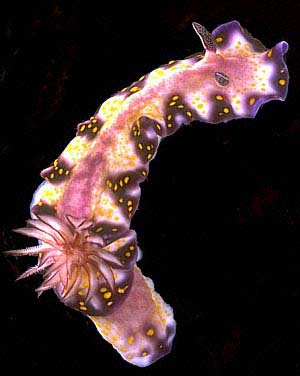
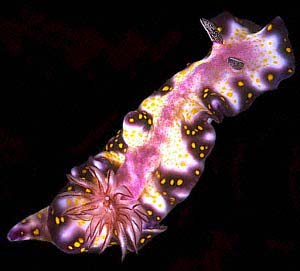
Risbecia godeffroyana
(Bergh, 1877)
Order: NUDIBRANCHIA
Suborder: DORIDINA
Family: Chromodorididae
DISTRIBUTION
Tropical western Pacific.
PHOTO
Solitary Islands, New South Wales, Australia. April 1987. PHOTOS: Bill Rudman.
Risbecia godeffroyana was originally described from Tahiti, and more recently reported (Rudman, 1987), from tropical Eastern Australia and Papua New Guinea. The background colour is creamy white. There is a dark purplish blue border with fingers of the extending into the central part of the mantle. Inside the purple border is a creamy white band with small yellow spots. The central part of the mantle usually has a pinkish tinge and many yellow spots, often smaller than those on the cream background. Sometimes these spots are take on the pinkish colour of the background.
Risbecia godeffroyana is very similar in colour to the Hawaiian R. imperialis and it feeds on a blue-grey sponge, very similar to Dysidea fragilis, the preferred food of R. imperialis in Hawaii (Bertsch & Johnson, 1981). The East African R. pulchella is clearly closely related, the main external difference being the purple border to the foot in that species, and the smudged pale purple reticulate pattern on the dorsum.
Reference:
• Rudman, W.B. (1987). The Chromodorididae (Opisthobranchia: Mollusca) of the Indo-West Pacific: Chromodoris epicuria, C. aureopurpurea, C. annulata, C. coi and Risbecia tryoni colour groups. Zoological Journal of the Linnean Society, 90: 305-407.
Note added 9 Jan 2001: R. imperialis and R. godeffroyana have previously been considered on the Forum to be colour forms of one species with all records being placed on the R. imperialis page. They are now separated as two species. See accompanying message.
Authorship detailsRudman, W.B., 2001 (January 9) Risbecia godeffroyana (Bergh, 1877). [In] Sea Slug Forum. Australian Museum, Sydney. Available from http://www.seaslugforum.net/find/risbgode
Related messages
Risbecia godeffroyana from Great Barrier Reef
November 24, 2007
From: Andrew Trevor-Jones
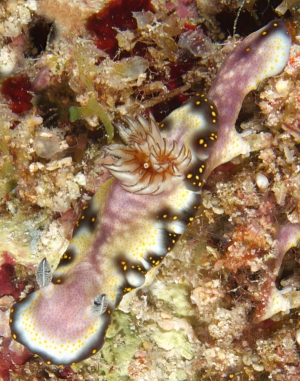
Hey Bill,
I haven't been able to identify this nudibranch from the northern Great Barrier Reef (Ribbon Reef #10).
Locality: Lighthouse Bommie, RR#10, Great Barrier Reef, 15.7 metres, Queensland, Australia, Pacific, 27/05/2007, Coral Pinnacle. Length: 3-5 cm. Photographer: Andrew Trevor-Jones.
Andrew Trevor-Jones
atj777@attglobal.net
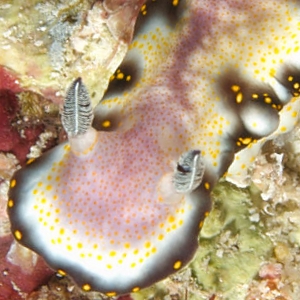
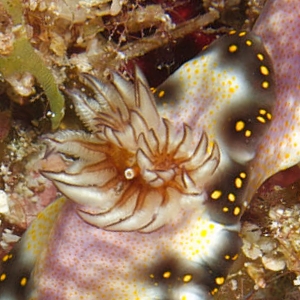
Dear Andrew,
This is the chromodorid Risbecia godeffroyana. I have included a couple of close ups to show the detail in the colour pattern and the gills. The white ring in the centre of the gills is the tip of the anal papilla.
As you can see, the gills in this species do not form a simple circle. Instead on each side they form an inwardly coiling spiral which greatly increases the number of gills. I have not collected diligent statistics on this but the species which form inward spirals like this are the larger species which have thicker, more muscular, body walls. In species with a thinner body wall I suspect the body wall acts as a secondary gill allowing some passage of gases. My hypothesis is that as the body wall thickens and can no longer act as a semipermeable membrane, the need to increase the number of gills becomes important. With the microprobes available today it might be an interesting little project for someone.
Best wishes,
Bill Rudman
More Risbecia godeffroyana feeding
August 30, 2006
From: Nerida Wilson
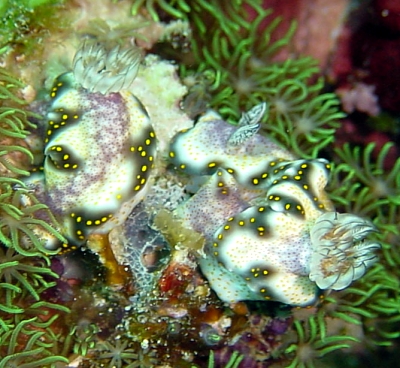
Dear Bill and others,
I recently came across this pair of Risbecia godeffroyana feeding. Once I removed one of the animals, you could see the sponge skeleton remaining.
Locality: Gulewa, Misima Island, 7m, Papua New Guinea, 14 August 2006, Reef wall, low current area. Photographer: Nerida Wilson.
Cheers
Nerida
wilsong@auburn.edu
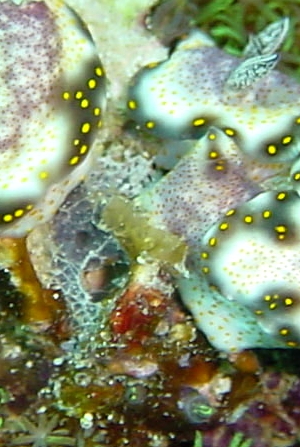
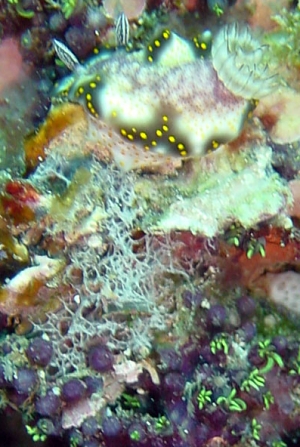
Dear Nerida,
This is an excellent follow-up to Bruce Wilkie's message [#17600], as the skeleton is definitely a dysideid and most probably Euryspongia. A good example can be seen in Scott Johnson's Hypselodoris maculosa message [# 2155]. This sponge seems to be rather inept at protecting itself from overgrowth, in this case by the cnidarian colony.
Best wishes,
Bill Rudman
Risbecia godeffroyana feeding & trailing [1]
August 29, 2006
From: Bruce Wilkie
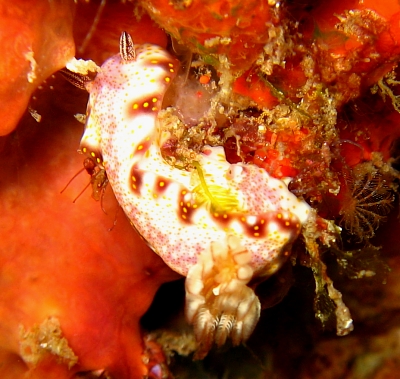
Hi Bill,
Looking through the Forum there didn`t seem to be much on Risbecia godeffroyana. I have included photos on trailing and also feeding. I hope they are a help to the Forum.
Locality: Flat Rock North Stradbroke Island, Queensland, Australia, Pacific Ocean. Upper right photo: 8 m, 11th December 2005, Rocky reef with hard & soft corals & sponges. Middle photos: 13 August 2006, Depth 10 m. Lower right photo: 12 March 2006, Depth 8 m. Photographer: Bruce Wilkie.
I am posting a 2nd message with more photos
Many Thanks
Bruce Wilkie.
brucedwilkie@yahoo.com.au
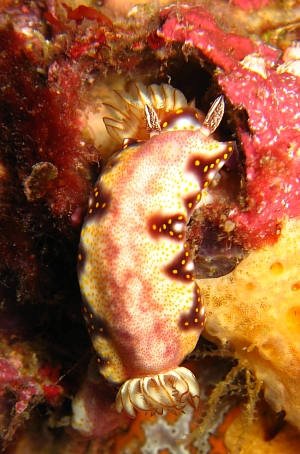
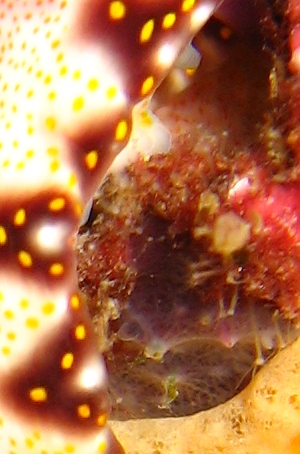
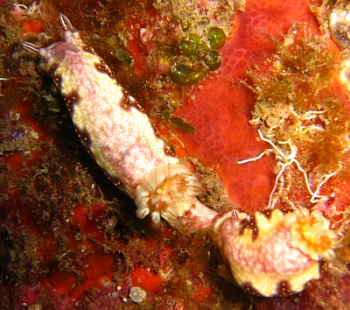
Dear Bruce,
Thanks very much. Another very valuable contribution. In the upper right photo we have the usual tantalising situation where it seems to be feeding but I am not sure on what. I am pretty sure it is not the bright orange-red sponge but most probably the whitish translucent patch just below the head. However in the middle left photo there are two animals which seem to have excavated a huge feeding hole. All we can see of the upper animal is its gills. I am pretty sure what they are eating is the greyish sponge - a species of Euryspongia - which you can see in the close-up on the right. It seems the Euryspongia colony is partly overgrown by the yellow sponge at the bottom and the reddish sponges on either side of the hole. I haven't posted your whole photo but in it I can see more patches of the greyish sponge further away. The way these sponges compete for space by overgrowing each other certainly makes identifying nudibranch food sources very difficult. It also make sampling colonies difficult because it is often impossible to get a sample of one species without contamination from other nearby species
These trailing photos certainly give the impression, as Roberto Sozzani suggested [message #17592 ] that these animals can't bear to be apart.
Best wishes,
Bill Rudman
Risbecia godeffroyana feeding & trailing [2]
August 29, 2006
From: Bruce Wilkie
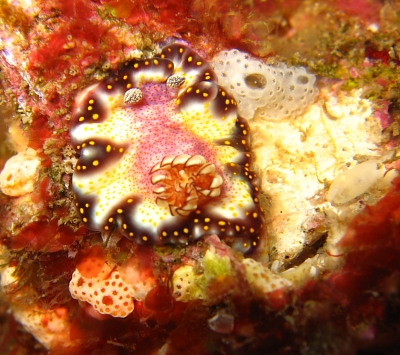
Hi Bill,
Here are some more photos to accompany my previous message [#17600 ].
I observed the animal in the upper right photo over a period of 8 days. It was found sitting in a small hollow which was void of growth. I don`t know if it cleared (ate) the growth that was in there. Over this period it hardly moved at all and the next day it had disappeared. There was also no sign of any egg ribbons in the general area. I thought it a odd that I just stayed there and didn`t seem to do anything.
In the bottom of the middle photo there are some more animals, I am not sure if they are juvenile R. godeffroyana?
Locality: North Stradbroke Island, Queensland, Australia, Pacific Ocean. Upper right photo: Shag Rock, 3 m, 23rd April 2006, Rocky reef with hard & soft corals & sponges. Middle photos: Flat Rock, 30th June 2006. Depth 12m. Lower right photo: Flat Rock, 29th April 2006, Depth 8 m.
Photographer: Bruce Wilkie.
Many Thanks
Bruce Wilkie.
brucedwilkie@yahoo.com.au
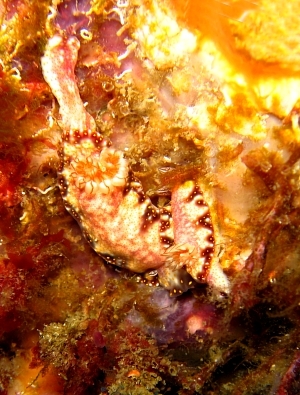
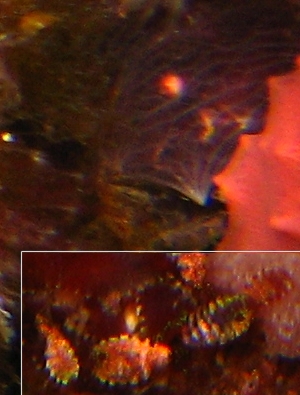
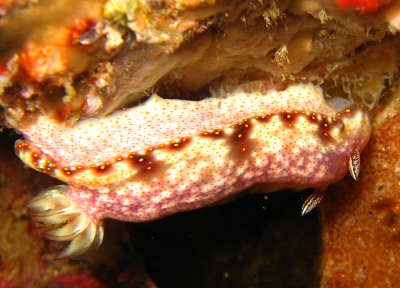
Dear Bruce,
Thanks again. I am so glad you have found the time to look through your slides. I can't add anything to your comments on your upper photo. It looks like it just decided to take 'time out'. I haven't room to display the whole of your photo 3 so the two middle photos, and the inset, are parts of it. It is very interesting. You can see in the left photo that there are patches of purple. When you look at them carefully in your original photo there are clear signs they have been eaten. I suspect there is a large colony of this purplish sponge which is being covered by other sponges and plant growths. In the right photo, I have included a close-up of part of the purplish sponge in the hollow just to the bottom right of the other photo. This is clearly Euryspongia, which is what I suspected was the food sponge in your earlier message. So it confirms my thoughts in that message that Euryspongia colonies are the food of Risbecia godeffroyana, and they are often usually overgrown, making their presence almost impossible to detect by the casual observer.
I have added the 'other animals' possible juveniles? in an inset. Although a couple look like slugs, I suspect they are jointed animals, crustacea? or worms? I am afraid I can't say anything about the lower photo, but after the positive identification of Euryspongia in the other photo, I am not complaining.
Best wishes,
Bill Rudman
Risbecia godeffroyana from Bali
March 23, 2002
From: Stuart Hutchison
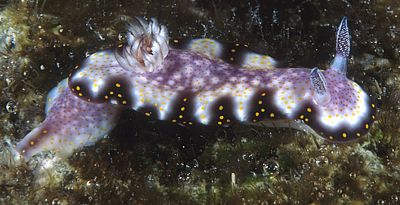
Hi Bill,
Here's Risbecia imperialis from Milne Bay, Papua New Guinea on 3 Apr 1999.
50mm long at 2m depth near the intertidal zone on algae covered rocks.
Regards,
Stuart
stuart@stuarthutchison.com.au
Hutchison, S., 2002 (Mar 23) Risbecia godeffroyana from Bali. [Message in] Sea Slug Forum. Australian Museum, Sydney. Available from http://www.seaslugforum.net/find/6298Dear Stuart,
For a while I thought that Risbecia imperialis and Risbecia godeffroyana were colour forms of the same species but the colour differences between the two seem to be very consistent so I think we should retain them as separate species until we know more about their anatomy.
Best wishes,
Bill Rudman
Risbecia godeffroyana from the Solomons
January 10, 2001
From: Mary Jane Adams

Hi Bill,
Here is another Risbecia godeffroyana from Morovo Lagoon, Solomon Islands, November, 2000. Are those translucent oval patches behind the rhinophores the eyes?
Thanks!
Mary Jane
divepng@yahoo.com
Adams, M.J., 2001 (Jan 10) Risbecia godeffroyana from the Solomons. [Message in] Sea Slug Forum. Australian Museum, Sydney. Available from http://www.seaslugforum.net/find/3487Thanks Mary Jane,
The translucent oval patch behind the rhinophores can be seen in many chromodorids. It coincides with the position of the eyes which are sitting below the body wall on the cerebral ganglia. Sometimes you can see them through the body wall as two tiny black spots. Have a look at the page on the dorid head.
The eyes in these animals can't form an image and basically can sense light and dark, passiing shadows etc. I suspect the translucent patch, devoid of pigment, enables at least some light to pass through the body wall to reach the eyes.
Best wishes,
Bill Rudman
Risbecia imperialis & R. godeffroyana
January 10, 2001
From: Bill Rudman
Risbecia imperialis from Hawaii and Risbecia godeffroyana, with a more widespread distribution in the Western Pacific are two very similarly coloured species of chromodorid. There is little anatomical information available on R. imperialis. However when I was preparing a page for these species on the Forum I felt that they were probably just geographical colour forms of one widely distributed species. To stimulate discussion on the Forum I placed both 'species' on the R. imperialis page.
Since I can't substantiate this 'feeling' and because it is causing confusion amongst visitors to the Forum I have, as promised recently, now separated them as two species.
However this does mean we should stop thinking about the relationships of these 'species' to each other, so please don't stop looking for R. imperialis-like animals in places other than Hawaii.
Bill Rudman.
Risbecia from Solomon Ids?
January 8, 2001
From: Bruce Potter
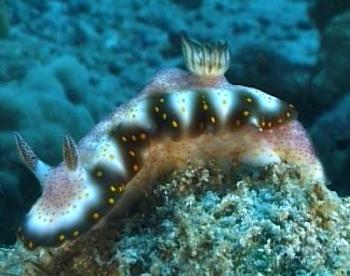
Dear Bill,
I have followed the debate about Risbecia imperialis/godeffroyana and am still somewhat confused. I have found several around Honiara, in the Solomon Islands, and they all look like this one. Is it R. imperialis or R. godeffroyana?
Thanks for your help.
Regards
Bruce Potter.
bruce.potter@adventist.org.sb
Potter, B., 2001 (Jan 8) Risbecia from Solomon Ids?. [Message in] Sea Slug Forum. Australian Museum, Sydney. Available from http://www.seaslugforum.net/find/3393Dear Bruce,
At this stage all I can do is refer you to my message to Mary Jane Adams. Basically I put the two species together hoping to stimulate some discussion. However since the Forum is also used as an identification guide this is very confusing for people like you. When I get a chance I will split them in two again. So call your animal R. godeffroyana.
Best wishes,
Bill Rudman
Note added 9 Jan 2001: R. imperialis and R. godeffroyana have previously been considered on the Forum to be colour forms of one species. They are now separated as two species, this animal being R. godeffroyana .
Rudman, W.B., 2001 (Jan 8). Comment on Risbecia from Solomon Ids? by Bruce Potter. [Message in] Sea Slug Forum. Australian Museum, Sydney. Available from http://www.seaslugforum.net/find/3393Risbecia godeffroyana? from Solomon Ids
September 6, 2000
From: Mary Jane Adams
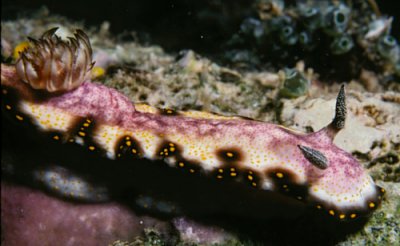
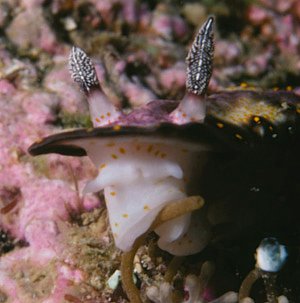
Hi Bill,
I took these photographs in the Solomon Islands in November, 1987. Unfortunately, I didn't record the exact location or depth. Do you think Risbecia imperialis is a better name for this than R. godeffroyana?
Thanks!
Mary Jane
mjadams@earthlink.net
Adams, M.J., 2000 (Sep 6) Risbecia godeffroyana? from Solomon Ids. [Message in] Sea Slug Forum. Australian Museum, Sydney. Available from http://www.seaslugforum.net/find/2952Dear Mary Jane,
This is another intersting question. basically with little anatomical to go on, where do you draw the line?. When I first saw good photos of R. imperialis I considered it to be just when end of range of colour variation which included what I had previously called R. godeffroyana. However after about a year's reflection - but no new information I must add - I am now thinking perhaps that the Pacific form [R. godeffroyana] with small spots should be considered separate from the Hawaiian form [R. imperialis] with large yellow spots.
Any colour variants are still very welcome.
Best wishes,
Bill Rudman.
Note added 9 Jan 2001: R. imperialis and R. godeffroyana have previously been considered on the Forum to be colour forms of one species. They are now separated as two species, this animal being R. godeffroyana.
Rudman, W.B., 2000 (Sep 6). Comment on Risbecia godeffroyana? from Solomon Ids by Mary Jane Adams. [Message in] Sea Slug Forum. Australian Museum, Sydney. Available from http://www.seaslugforum.net/find/2952Risbecia imperialis from Vanuatu
January 27, 2000
From: Vinka Stenhouse
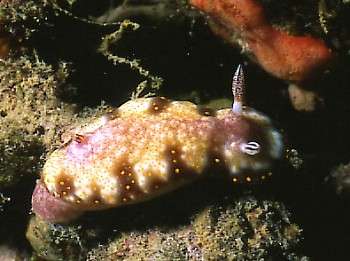
Dear Bill,
This one was photographed at 12m depth, Espiritu Santo Is., Vanuatu, 1998. It was 15mm long.
Yours sincerely,
Vinka Stenhouse.
Santo.
Vanuatu.
Dear Vinka,
This is a juvenile Risbecia imperialis.
Bill Rudman.
Note added 9 Jan 2001: R. imperialis and R. godeffroyana have previously been considered on the Forum to be colour forms of one species. They are now separated as two species, this animal being R. godeffroyana.
Rudman, W.B., 2000 (Jan 27). Comment on Risbecia imperialis from Vanuatu by Vinka Stenhouse. [Message in] Sea Slug Forum. Australian Museum, Sydney. Available from http://www.seaslugforum.net/find/1570